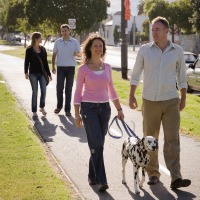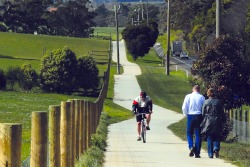Recreation and exercise
Walking is the most popular, affordable and readily attainable form of medium intensity physical activity, with more than a million Victorians actively walking for exercise. Walking is easily the most common form of exercise, with a participation rate estimated at 24.3%, compared to fitness/gym (17.6%), cycling/BMX (8.8%) and jogging/running (7.8%). Detailed information for Victoria and other states is available from the Australian Bureau of Statistics Participation in Sport and Physical Recreation, Australia, 2011-12.
A survey of 400 people in Perth in 2008 found 74% walked at least weekly for recreation or leisure, while 22% walked daily, but only 4% walked to work (Walking Attitudes and Behaviours Among Respondents in Perth Metro Area 2009).
Differences from travel walking

A distinction is often drawn between walking for transport (as a means of getting to a destination) and walking for recreation or exercise. In practice, there is likely to be considerable overlap - people may walk to the shop, for example, because they enjoy it.
When walking for transport, directness is critical and walkers will follow pedestrian desire lines, so infrastructure to direct walking elsewhere is unlikely to be successful. For recreational walking, the journey may be as important as the destination, although destinations are often still important.
Creating a pleasant urban environment for walking can encourage people to both:
- walk for recreation from home, rather than driving to a separate location to walk; or
- travel to another destination like work or shopping by walking.
The characteristics of recreational walking are discussed in the NSW Walking Strategy Literature Review.
Personal motivations are critical in walking for recreation or exercise. See the behaviour change section for ways to encourage people to choose to walk.
Walking women
Walking is particularly important as a recreational activity and form of exercise for women. Analysis of the Exercise Recreation and Sport Survey found that Australian women were 74% more likely to be regular walkers (more than 5 times a week) than men. Conversely, women were less likely to undertake other physical activity than men (Bauman et al, 2012, Active, healthy cities - how does population physical activity vary between Australian cities?).
Paths and trails
 Two Towns trail, Baw Baw Shire Council
Two Towns trail, Baw Baw Shire Council
Providing pleasant and interesting recreational paths and trails can encourage people to walk. Parks or beaches are great settings for recreational paths, but urban environments can also be highly successful.
Creating a trail may not require any infrastructure at all. In Horsham for example, the City Council created the Public Art and Heritage Trail using Victoria Walks' Walking Maps.
Councils should be cautious in relying on shared trails to provide for walking and cycling. Generally, slow moving recreational cyclists are able to give way to, and share paths with, walkers on low volume paths. However, large volumes of pedestrians or commuter cyclists, who typically travel at speed, do not mix well. Around 3% of pedestrian hospitalisations result from crashes with cyclists. See Pedestrian-Cyclist Collisions: Issues and Risk for more. Victoria Walks recommends separated paths or on-road cycle paths to promote cycling for transport.
VicRoads provides guidance on shared path design in Cycle Notes 21 and the more detailed Shared path audit guidelines. Planning should anticipate future growth including an increase in commuter cycling - almost three-quarters of recreational paths on the Metropolitan Trail Network, originally intended for leisure and low levels of transport use, now have high levels of transport use (Cycling into the Future 2013-23, p.24).